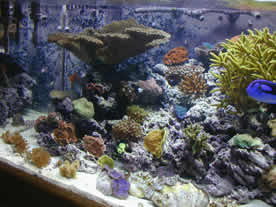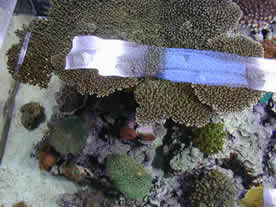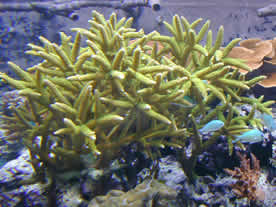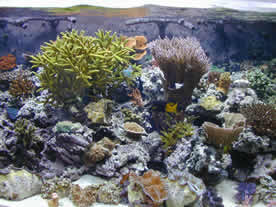A
lot of aquarists tell me that the most exciting part of a reef
is setting it up and stocking the tank. For others, the excitement
comes from watching the reef develop and change over time. A
reef tank is certainly a long-term commitment. I often remember
reading German articles, where they would describe a one year-old
reef as a new system. There are certainly a lot of things that
change within a reef aquarium over time. And what I'm discovering
is that the habits and practices of the reef keeper have to
change over time as well. This article is intended to address
long-term concerns, and suggest steps a reefkeeper should consider
taking with a reef aquarium that he/she intends to keep for
many years.
Keep the Variety and Number of Corals Low
Many of the choices a reefkeeper makes
when designing a new reef will determine the long-term health
of the system. People spend a lot of time and energy planning
the plumbing, lighting, and filtration. The Reef Central forums
are often filled with hundreds of questions concerning what
wattage lighting to purchase or which skimmer is best. Unfortunately,
little thought or research is put into stocking the reef.
The most detailed planning one may find concerning livestock
may be that a reefkeeper has decided to do an "SPS"
reef or a lagoon.
Once the reef aquarium is up and running,
it usually gets quickly filled with corals. Corals are placed
in close proximity to each other, without regard to growing
room or competition. Reefkeepers tend to plan their reef on
how they would like it to look immediately or how they foresee
it a few months from now. They do not plan their purchases
by what the reef will look like in several years. I'm certainly
guilty of this; it is hard to resist buying yet another coral
at the local fish store. But, the reality is that corals will
grow and compete. And some of the negative effects of this
competition and growth will not be manifested for years.
Look at the density of the corals on natural
reefs pictured in dive magazines or in sources like National
Geographic. One will see that there is very little "real
estate" available. But, also look at the diversity. One
will notice many similar or same types and/or species of coral
growing together. Now, compare such a picture to a reef tank.
One will see that we are bunching way too many corals of different
varieties into too small of a space. The problem with this
kind of crowding is that there is going to be more interspecific
competition between corals in the reef tank as a result. Competition
is a source of stress, and eventually, some corals are going
to be out-competed by others. Byproducts of chemical competition
may also do more harm in an aquarium compared to a natural
reef because it is a small, closed body of water. Such chemical
byproducts could build up in the system over time.
  |
|
A gorgonian-dominated sand flat in
the Florida Keys.
|
By reducing competition, the reef aquarium
is going to be much healthier in the long term. Over time,
stronger competitors will always win out over those that are
not as competitive. If one were to stock a tank full of coral
species, and then not add any more for the life of the tank,
eventually, only a few would remain. It may take years, but
it will happen. The reality is that most reefkeepers will
keep adding more corals to replace those that have been lost.
This perpetuates the problem, and will ultimately be the cause
for more losses. Pruning certainly helps prevent a lot of
direct competition from occurring, but I think pruning should
be complimentary to low stocking levels. The same can be said
for other preventative measures, like using carbon and water
changes to dilute the byproducts of chemical competition.
When planning an ideal and natural reef,
one should consider keeping the diversity of corals to a minimum.
Intraspecific competition is easier to deal with than interspecific
competition. The problem is, nobody wants a tank full of the
same corals. It's more enjoyable to buy a new and different
type of coral. That's what makes visiting the LFS so much
fun! It is the desire to find something new and unique!
But, a tank can still be very beautiful
with a lower variety of species. At the Ft. Lauderdale MACNA
convention, Julian Sprung displayed some striking photographs
of reef aquariums around the world. One notable aquarium consisted
of a single large Acropora colony filling a cube-shaped tank.
The tank also contained many small damsels that hid among
the coral's branches. It was inspiring. I also see a lot of
reefkeepers reach a point where they strive for their reef
to be more natural, or perhaps geographically specific. Hopefully,
such trends will become more popular to help alleviate a constant
desire to add something new and different. Another benefit
to a more natural tank with lower coral diversity is that
it will also offer more natural behaviors and trends to observe.
An analogy with fish stocking levels provides
further support for my argument here. Coral reefs are teeming
with fish. The unwitting aquarist may use this observation
to justify overstocking a tank with fish. The correct response
to this action is that the ocean contains a much larger volume
of water and more ways to process nutrients than a small glass
box full of water. I suggest approaching coral stocking levels
the same way. I certainly haven't always practiced what I've
preached. My previous reef tanks have been stocked to the
brim with corals of many different types. But, I certainly
intend to plan future reef aquariums accordingly. I think
it will be much more rewarding to have fewer, but larger,
corals than to have many small "bonsai" corals that
I must prune frequently.
Monitor and Adjust Current and Light in
a Reef Aquarium Over Time
Adequate light and good water flow are
vital to a healthy reef aquarium. As the quality of light
and current change, so does the health of the reef aquarium.
It is important to replace lamps regularly. It is generally
well known that lamps will diminish in intensity as they age.
Pumps and powerheads will also produce less current as the
tubing and impellors become restricted with the build-up of
fouling material. It is recommended to clean pumps and tubing/PVC
regularly. Several years of buildup can make a significant
impact on flow.
Another factor that causes changes in light
intensity and current is the very thing one strives for...coral
growth! As corals grow, they block areas of water flow. For
example, envision a small coral fragment mounted near a powerhead.
As this fragment develops into a large colony, it may block
the current generated by the powerhead, preventing it from
reaching other corals. As a coral grows larger, it may also
begin to shade corals below it. Sometimes, an aquarist will
be perplexed as to why a coral that has been thriving for
years suddenly begins to fade away and die. He/she notes that
none of the neighboring corals or fish seem to irritate it,
and that the water quality is high. But, perhaps other things
have changed. Perhaps a neighboring coral has grown considerably
and eventually reduced the flow or light reaching the now
ailing coral. I have found that certain small-polyped stony
corals, such as Acropora, are particularly sensitive
to this. Overtopping and flow restriction are indeed another
type of competition.
  |
|
Notice the table coral beginning to
shade the real estate below it.
|
As the reef continues to grow, it is worth
repeating the importance of keeping light and current optimal.
An easy solution is to add more light and more pumps/powerheads
to accommodate the growth. Repositioning them will help as
well. Pruning heavy growth will help prevent shading and reduced
water flow. Lower coral stocking densities also helps in this
regard.
  |
|
Rapidly growing corals, such as this
Acropora yongei, may impede water current in
the tank over time.
|
Maintain Biodiversity
The more biodiverse an ecosystem is, the
more stable it is. As species go extinct, not only is that
organism lost forever, but it contributes to the destabilization
of the ecosystem it inhabited. All organisms fulfill a role
or "niche" in an environment. In a sense, they all
work together to make the system work. The same principles
apply to an aquarium. One way diversity increases stability
is by increasing the complexity of the food webs and nutrient
pathways. As aquarists rely more and more on natural forms
of filtration such as deep sand beds, live rock, and macroalgae-filled
refugiums, they are beginning to understand the importance
of biodiversity.
I can remember a time when bristle worms
were the bane of every reef keeper's existence. Now, we admire
them fondly as "detritivores." A deep sand bed would
not function properly without the presence of various detritivores
to break down large organic particles in order to make this
material available to bacteria and smaller organisms. Other
fauna contribute by breaking up bacterial clumps and inorganic
material. There are also "critters" that contribute
to the health of the tank by grazing on algae or perhaps acting
as a food source for corals and fish. Unfortunately, many
of these critters eventually dwindle and disappear from the
tank over time. Predation from fish and corals, competition
from other critters, and random catastrophic events (like
a wild temperature swing from a failing air conditioner) all
contribute to the disappearance of these beneficial critters
from the reef aquarium. There are many steps an aquarist can
make to alleviate this loss of diversity.
One popular method to increase biodiversity
is to add a refugium. By definition, a refugium is an area
where organisms are allowed to thrive without the presence
of predators. This could be a separate tank or even a section
of the sump. Today, manufacturers are making hang-on-the-back
refugium units for aquariums. A refugium may alleviate the
predation problem for the organisms found there, but what
about the competition and random catastrophic events?
 |
|
Refugiums such as
the one above are relatively simple to add on to existing
systems, and are an effective way to maintain faunal
biodiversity in a reef aquarium.
|
In natural ecosystems, there is immigration
and emigration. Many organisms will move from one area to
another. If something catastrophic occurs and destroys a whole
population of trees or birds in a given habitat, neighboring
communities can help recolonize the area. In a reef tank,
this does not occur. Despite having a refugium to mimic some
of this recolonization, a reef tank is still a closed system.
Consider a tank as a very remote island. It is isolated. If
a particular population of organisms is eliminated from the
tank and refugium, there is no way for that type of organism
to recolonize the tank...unless the reefkeeper steps in.
I personally think it is good practice
to play Mother Nature from time to time and restock the tank
with micro- and meiofauna. Many online stores carry detritivore
"kits," which would allow one to re-establish some
of these critters in a reef aquarium. Another way is to replace
a couple of pieces of old live rock with fresh (cured) rock.
The new live rock can aid in reintroducing some of the lost
populations. Unfortunately, there is also a risk of reintroducing
nuisance organisms, but I think the benefits far outweigh
the risks.
Choosing fish wisely is another good way
to maintain diversity. Reducing the amount of predatory fish
will certainly help. Feeding more heavily and providing a
variety of food types and sizes will contribute to sustaining
a diverse reef, by meeting the nutrient demands of more organisms.
Support of this suggestion is found in the various comments
I hear from aquarists that begin feeding plankton substitutes.
They notice an increase in many organisms, from sponges to
microfauna.
Perhaps the reader may feel that the suggestion
of maintaining biodiversity conflicts with the suggestion
of keeping less corals, but many corals tend to fill the same
or similar niches. By maintaining diversity, I refer to the
goal of filling and maintaining a large variety of niches.
Simulate Storms
Detritus builds up in areas of the tank
despite our efforts to maintain large populations of detritivores,
strong current, and proper filtration. In a closed reef aquarium,
it may even become a problem. Some suggest that long-term
accumulation of detritus can lead to mysterious algae problems.
Others suggest that detritus can also clog the porous live
rock in our system, reducing the surface area on which bacteria,
sponges, and other filter feeders settle. I'm not entirely
sure if these concerns are legitimate, but I personally think
it is beneficial to occasionally simulate the action of storms
with large powerheads and other devices to remove detritus
build-up. I also try to occasionally manage stagnant areas
with a turkey baster when doing water changes. Stirring up
the detritus is also a good way to feed your corals. I would,
however, recommend only disturbing small pockets of detritus.
Disturbing large sinks of detritus, such as stirring a deep
sand bed, can have catastrophic effects on the tank. Releasing
large amounts of detritus will also release large densities
of aerobic bacteria and microbes into the water column. These
organisms may use up a lot of the free oxygen in the water
column thereby reducing the overall oxygen levels in the tank.
The freeing of large amounts of organic material may also
cause an algae bloom down the road.
Water Changes
The importance of water changes is obvious.
In aquariums housing only fish, water changes are often implemented
to dilute the buildup of nitrogenous waste. However, they
act to dilute other things in a reef aquarium. Other detrimental
elements originating from food, impurities in top-off water,
and other inputs can accumulate if not removed. Water changes
will dilute these elements, as well as the possible products
of plant and animal metabolisms, such as the toxic chemicals
released by soft corals. Water changes also replenish elements
not provided by additives and food. It should be little wonder
why corals tend to perk up after a water change.
Logbooks
A detailed logbook becomes an asset of
information over time. Events that occur in a reef tank are
not always a result of recent changes. They could be a result
of something the reefkeeper did a long time ago. For example,
changes in feeding, additives, or frequency of water changes
may not cause any immediate effects in an aquarium. It may
take months or even longer for the effects of such changes
to show. A detailed log is a useful tool in helping to solve
these mysterious changes that may occur over time. By logging
quantities of items added to the tank, changes to lighting
and temperature, and other notable information, one suddenly
finds variables that might be able to explain current happenings.
Conclusion
These are just a few suggestions
to help keep a reef aquarium thriving for many years to come.
But, be aware that a reef will evolve and change. As years
pass, one may suddenly discover that a tank will no longer
support certain corals, no matter how many times the reefkeeper
attempts to reintroduce them. The tank is not necessarily
going to evolve the way an aquarist wants it to. But, that
does not make the system a failure. It's important for an
aquarist to evolve, as well, and learn the limitations of
his/her reef. I also think it's important that those who have
successfully kept reef aquariums over long periods of time
submit their ideas and methodologies that they believe contributed
to their success (or failure). I would like to hear from you!!
|

